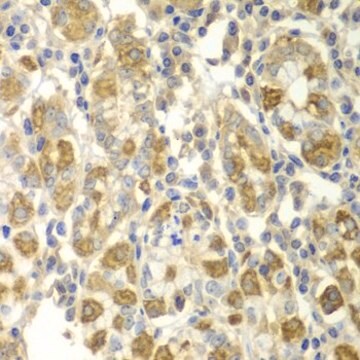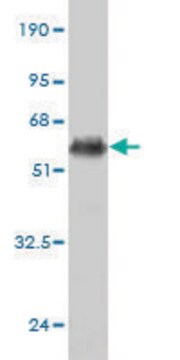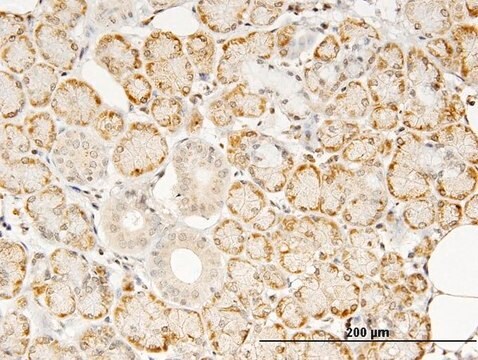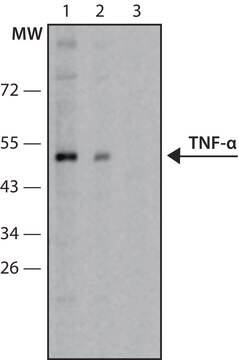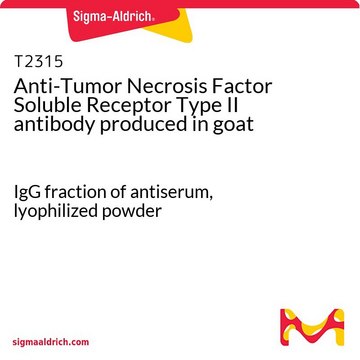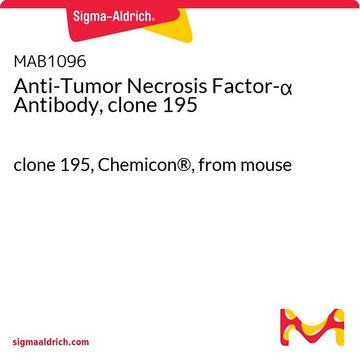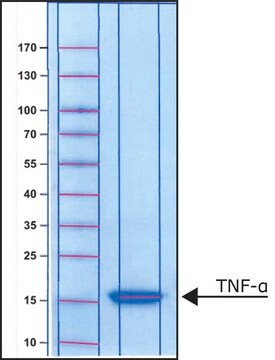T3198
Monoclonal Anti-Tumor Necrosis Factor-α antibody produced in mouse
clone 45418.111, purified immunoglobulin, lyophilized powder
Synonym(e):
Anti-TNF-α
About This Item
Empfohlene Produkte
Biologische Quelle
mouse
Qualitätsniveau
Konjugat
unconjugated
Antikörperform
purified immunoglobulin
Antikörper-Produkttyp
primary antibodies
Klon
45418.111, monoclonal
Form
lyophilized powder
Speziesreaktivität
rat
Methode(n)
capture ELISA: suitable
neutralization: suitable
western blot: 1-2 μg/mL
Isotyp
IgG1
UniProt-Hinterlegungsnummer
Lagertemp.
−20°C
Posttranslationale Modifikation Target
unmodified
Angaben zum Gen
rat ... Tnf(24835)
Allgemeine Beschreibung
Immunogen
Anwendung
Biochem./physiol. Wirkung
Tumor necrosis factor-α (TNFα) affects various cellular processes such as blood-brain barrier, inflammatory, thrombogenic and vascular changes following brain damage. TNFα expression is upregulated in various central nervous system disorders, including Alzheimer′s disease, multiple sclerosis, Parkinson′s disease, meningococcal meningitis and human immunodeficiency virus (HIV) infection. Elevated expression of TNFα in the brain and blood in response to lipopolysaccharide might increase brain stem thrombosis, hemorrhage and stroke sensitivity/risk in hypertensive rats. Tumor necrosis factor-α activates polymorphonuclear leukocyte NADPH oxidase, thereby facilitates development of systemic oxidative stress (OS), inflammation and hypertension in rats.
Physikalische Form
Haftungsausschluss
Sie haben nicht das passende Produkt gefunden?
Probieren Sie unser Produkt-Auswahlhilfe. aus.
Lagerklassenschlüssel
11 - Combustible Solids
WGK
WGK 3
Flammpunkt (°F)
Not applicable
Flammpunkt (°C)
Not applicable
Persönliche Schutzausrüstung
Eyeshields, Gloves, type N95 (US)
Analysenzertifikate (COA)
Suchen Sie nach Analysenzertifikate (COA), indem Sie die Lot-/Chargennummer des Produkts eingeben. Lot- und Chargennummern sind auf dem Produktetikett hinter den Wörtern ‘Lot’ oder ‘Batch’ (Lot oder Charge) zu finden.
Besitzen Sie dieses Produkt bereits?
In der Dokumentenbibliothek finden Sie die Dokumentation zu den Produkten, die Sie kürzlich erworben haben.
Unser Team von Wissenschaftlern verfügt über Erfahrung in allen Forschungsbereichen einschließlich Life Science, Materialwissenschaften, chemischer Synthese, Chromatographie, Analytik und vielen mehr..
Setzen Sie sich mit dem technischen Dienst in Verbindung.